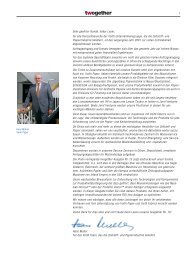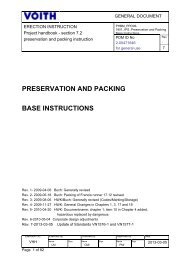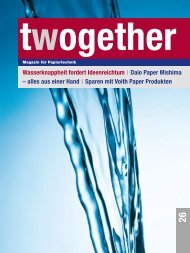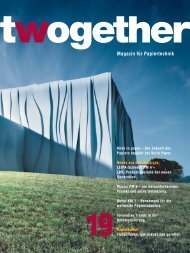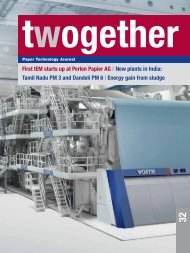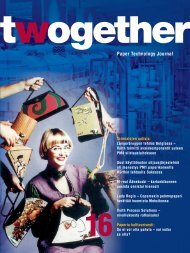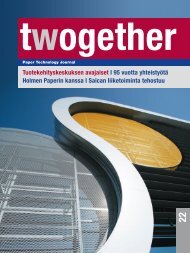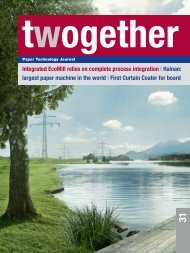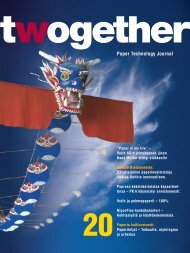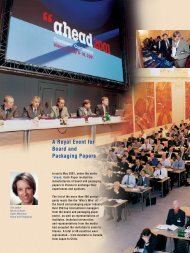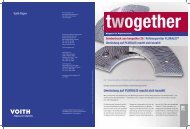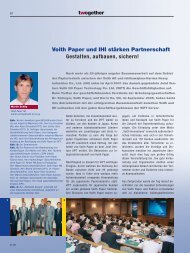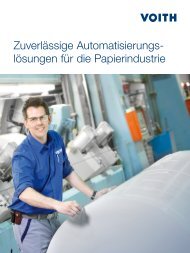You also want an ePaper? Increase the reach of your titles
YUMPU automatically turns print PDFs into web optimized ePapers that Google loves.
ASN (Average size number)<br />
Dryness after 2nd press<br />
55<br />
50<br />
45<br />
40<br />
59<br />
58<br />
57<br />
56<br />
55<br />
54<br />
53<br />
52<br />
3.3 dtex 5 dtex 11 dtex <strong>17</strong> dtex<br />
Very fine<br />
batt<br />
Medium<br />
batt<br />
PrintFlex P<br />
5<br />
Fabric permeability, cfm<br />
70<br />
60<br />
50<br />
40<br />
30<br />
20<br />
10<br />
0<br />
Very fine<br />
batt<br />
Fabrics<br />
Fig. 1: ASN for press fabrics with different<br />
surface properties.<br />
Fig. 2: ASN index comparison for press fabrics<br />
having different surface properties.<br />
New<br />
After running<br />
Fig. 3: FIN index comparison for press fabrics<br />
having different surface properties.<br />
New<br />
After running<br />
1 60<br />
2 55<br />
3<br />
4<br />
PrintFlex P, forms stage 2 of <strong>Voith</strong><br />
Fabrics ‘4-stage platform’ for pressing.<br />
PrintFlex P is composed of a surface<br />
made of fine batt fiber, layered with engineered<br />
resin components. It provides an<br />
extremely high degree of pressing uniformity,<br />
with excellent wear resistance.<br />
Figs. 2 and 3 show the comparison of<br />
results between a ‘standard’ press fabric,<br />
with a fine 6.7 dtex surface, and Print-<br />
Flex P.<br />
It can be observed that the PrintFlex P<br />
has an ASN number almost 10 % lower<br />
than the ‘standard’ fabric. The FIN index,<br />
shows over 40 % improvement for Print-<br />
Flex P over the ‘standard’ fabric surface.<br />
ASN (Average size number)<br />
50<br />
45<br />
40<br />
35<br />
30<br />
PrintFlex P 6.7 dtex<br />
surface<br />
Figs. 2 and 3 show the comparison of<br />
ASN and FIN between new and used fabric.<br />
Analysis of the fabric permeabilities<br />
showed that the PrintFlex P retained over<br />
33 % of more of its original permeability<br />
after use, compared to the ‘standard’ design.<br />
It is important to also note that despite<br />
the application of the engineered<br />
resin components, the PrintFlex P design<br />
was manufactured to the same level of<br />
starting permeability as the ‘standard’<br />
design.<br />
Mechanical abrasion tests have also<br />
demonstrated the high wear resistant<br />
properties of PrintFlex P. Again, compared<br />
to the ‘standard’ design, PrintFlex P<br />
Medium<br />
batt<br />
PrintFlex P<br />
Fig. 4: After press dryness results for different<br />
batt structures – VPM4.<br />
Fig. 5: Permeability of press fabrics<br />
New – VPM4.<br />
FIN<br />
60<br />
50<br />
40<br />
30<br />
20<br />
10<br />
0<br />
61<br />
gave almost 10 % less weight loss. The<br />
benefits of this can be seen from the case<br />
study shown in Fig. 9.<br />
Dryness/Rewet<br />
PrintFlex P 6.7 dtex<br />
surface<br />
Initial evaluations of PrintFlex P were carried<br />
out on the VPM4 pilot machine in<br />
Heidenheim, Germany, to investigate the<br />
influence of fabric surface properties on<br />
sheet dryness and sheet quality. An SC<br />
magazine furnish was used for the tests.<br />
Three different sets of press fabrics having<br />
different surface properties were tested:<br />
a ‘fine’ (3.3 dtex), ‘coarse’ (<strong>17</strong> dtex)<br />
and PrintFlex P.<br />
Dryness values were taken after the second<br />
press (Fig. 4). PrintFlex P provided<br />
the highest dryness values of over 55 %.<br />
Another important aspect to consider is<br />
the permeability of the press fabrics. The<br />
PrintFlex P had a permeability of 58 cfm,<br />
the ‘medium batt’ fabric 63 cfm, whilst<br />
the ‘very fine’ fabric only 18 cfm (Fig. 5).<br />
<strong>17</strong>/04



